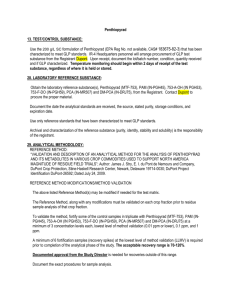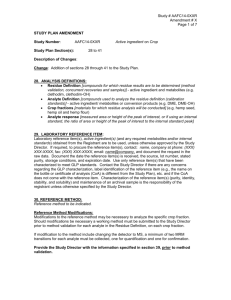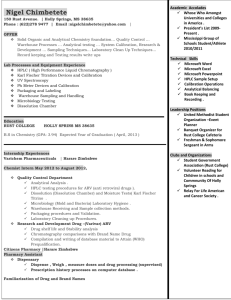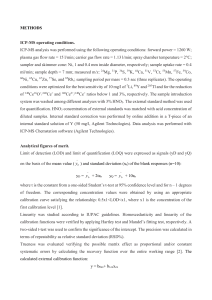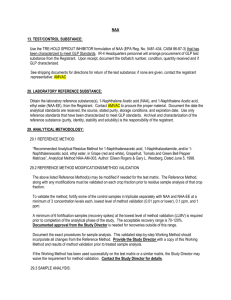rfp_13 - Buyandsell.gc.ca
advertisement
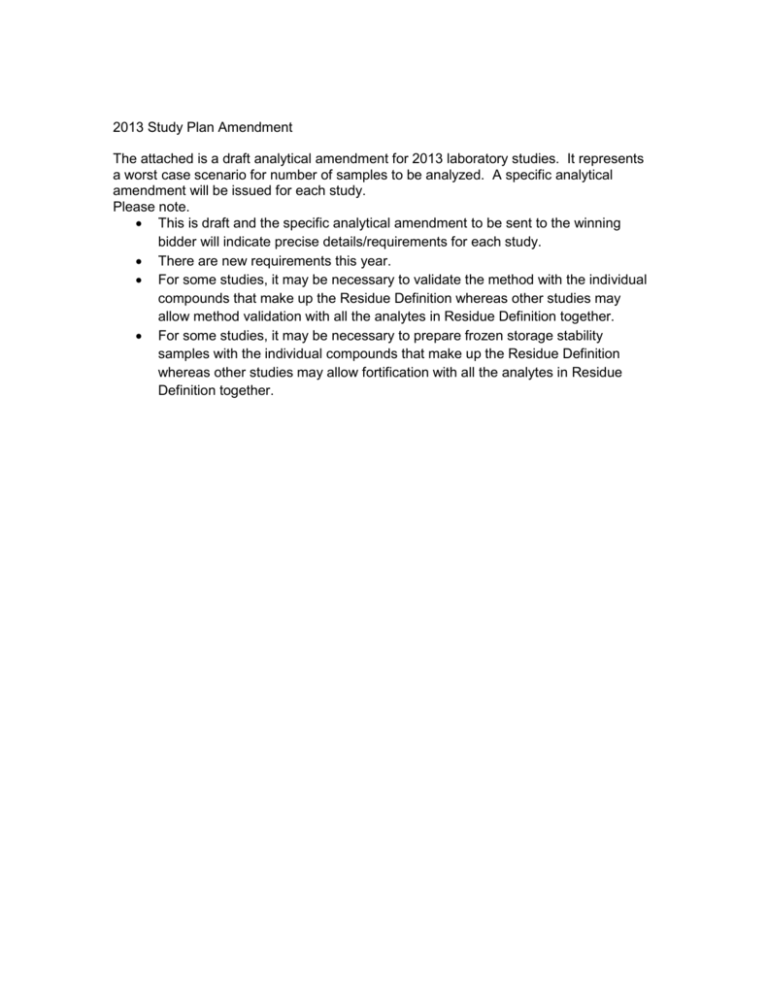
2013 Study Plan Amendment The attached is a draft analytical amendment for 2013 laboratory studies. It represents a worst case scenario for number of samples to be analyzed. A specific analytical amendment will be issued for each study. Please note. This is draft and the specific analytical amendment to be sent to the winning bidder will indicate precise details/requirements for each study. There are new requirements this year. For some studies, it may be necessary to validate the method with the individual compounds that make up the Residue Definition whereas other studies may allow method validation with all the analytes in Residue Definition together. For some studies, it may be necessary to prepare frozen storage stability samples with the individual compounds that make up the Residue Definition whereas other studies may allow fortification with all the analytes in Residue Definition together. Study # AAFC13-0XXR Amendment # X Page 1 of 6 2013 STUDY PLAN AMENDMENT Study Number: AAFC13-0XXR Study Plan Section(s): Active ingredient on Crop 28 to 35 Description of Changes: Change: Addition of sections 28 through 35 to the Study Plan. 28. LABORATORY REFERENCE ITEM: Obtain the laboratory reference item(s), active ingredient(s) (and any required metabolites and/or internal standards) from the Registrant. Contact name, company at phone: (XXX) XXX-XXXX, fax: (XXX) XXX-XXXX, email: name@company to procure the reference item(s). The request is to be documented in the raw data. Document the date the reference item(s) is received, the source, lot number, stated purity, storage conditions, and expiration date. Use only reference item(s) that have been characterized to meet GLP standards. Contact the Study Director if there are any concerns regarding the GLP characterization, label identification of the reference item (e.g., the name on the bottle or certificate of analysis (CoA) is different from the Study Plan), etc. and if the CoA does not come with the reference item. Characterization of the reference item(s) (purity, identity, stability, and solubility) and maintenance of an archival sample is the responsibility of the registrant unless otherwise specified by the Study Director. 29. STANDARD SOLUTION PREPARATION AND STABILITY: At a minimum, run five calibration standards, prepared from at least two different stock solutions (i.e., individually prepared from different weighings of the reference item). Use at least two calibration standard solutions per stock solution prepared from the different weighings to develop the calibration curve; the standards should be prepared alternately1 from the two stock solutions. Ensure that the concentration range includes the LOQ towards the lower end of the curve. It is also imperative that the LOQ is not the lowest or highest standard used. The analyte response area/height for the calibration standards must bracket the analyte response area/height of the fortification samples and treated samples with residues above the LOQ. The use of a zero standard/blank as part of the calibration series is not acceptable. Standard and stock solutions stability shall be demonstrated in the same solvent and storage conditions used in the study. This is to be done by analyzing a solvent/reagent blank, to ensure there is no interference, and then comparing the response factor (typically five replicate injections) of the aged stock solution (aged for the longest time period the standard was used in the study) to the response factor (typically five replicate injections) of a freshly prepared stock solution. The analyte will be considered stable in solution if the response factor of the aged standard is within 10% of the freshly prepared standards. Values outside of this range may require re-analysis as determined by the Study Director and Principal Investigator. 30. ANALYTICAL METHODOLOGY: REFERENCE METHOD: Reference method to be indicated. 1 Acceptable examples are (X, O, X, O, X), or (X, X, O, O, X, X), etc., but not (X, X, X, O, O), where X is the calibration standard prepared from the first stock solution and O is the calibration standard prepared from the second stock solution. Study # AAFC13-0XXR Amendment # X Page 2 of 6 Instructions for Setup of All Analytical Sets Sample Extract Storage All extracts should be stored in a refrigerator2 for no longer than 14 days. Contact the Study Director if sample extracts are stored greater than 14 days prior to analysis. Concurrent fortifications may be used to show extract stability, as long as the concurrent fortifications have been stored at least as long as the sample extracts obtained from the field samples and under the same conditions. Injection Sequence In each analytical set, a complete calibration set (all standards used to prepare the curve) must be injected before the first and after the last field sample. Additional calibration standards may be interspersed during the analytical run to ensure goodness of fit to the standard curve. Conditioning standards, samples, or solvent may be injected before the start of the run to ensure the entire system was primed and conditioned, but they must be clearly designated. Each injection set (including those with reinjected or diluted sample extracts) should include calibration standards, an untreated sample, the fortified untreated sample, a reagent/solvent blank, and treated samples. The untreated sample or solvent/reagent blank is to be injected immediately following the highest analytical standard. All field and fortified sample injections must be made in duplicate. The difference in response should be less than 10%. Otherwise, the vial should be re-injected in duplicate and/or other remedial action taken. The mean residue value from the two injections is to be reported and used in all subsequent calculations. Matrix-matched Standards If matrix-matched standards are used to develop the method validation calibration curve, then a calibration curve using solvent-based standards must also be generated for comparison. Study Director approval is required to continue use of matrix-matched standards for sample analysis. REFERENCE METHOD MODIFICATIONS/METHOD VALIDATION: The method may be validated using store purchased (preferably organic) crop fraction prior to the receipt of the field samples or using one of the untreated field samples. It may be necessary to modify the reference method, if interferences arise due to the test matrix. Note, the reference method, along with any modifications must be validated individually for each compound in the Residue Definition (active ingredient and metabolites), on each crop fraction, prior to residue sample analysis of that crop fraction. To validate the method, analyze a minimum of one control sample and a minimum of three replicates for each crop fraction, at each of three levels of fortification: the limit of quantitation (LOQ = XXX ppm [from reference method]), 2X LOQ and 10X LOQ. The control (untreated sample) or solvent/reagent blank is to be injected either immediately following the highest analytical standard or after the 10X LOQ sample to demonstrate that sample carryover is not occurring. The minimum number of validation samples will be 10. The acceptable recovery range is 70-120%, with an overall %RSD of ≤20%. Documented approval from the Study Director is needed for all recoveries outside of this range. If the results are unacceptable, the Study Director may request that the method validation be repeated. Document the exact working method, with “stopping points”, that will be used for sample analysis. This validated step-by-step working method must incorporate and outline all changes from the reference method. Provide the Study Director with a copy of this working method, along 2 Refrigerator refers to storage temperatures of generally 2 to 9°C, with normal variations due to door opening, etc. Study # AAFC13-0XXR Amendment # X Page 3 of 6 with the results of method validation (including chromatograms of the standards, fortified samples and control (untreated) sample), Certificate of Analysis for reference item(s), worksheets for preparation of stock and other standard solutions, and worksheets for preparation of long-term frozen3 storage stability samples for Study Director approval, prior to analyzing the treated samples. Method Validation Extension During sample analysis, if residue levels are greater than the highest concentration validated, the method validation will be extended by analyzing three replicates of a control sample fortified at a concentration above the highest level of residues found and an additional control sample is to be analyzed after the fortified samples. This requirement is in addition to the concurrent recovery above the highest residue found in the samples. SAMPLE ANALYSIS: Samples will be analyzed and reported for the Residue Definition of the test item, (i.e., active ingredient and metabolite), following the successful validation of the working method. For each field trial associated with this study, analyze at least one control (untreated) and all treated residue samples for each crop fraction, in the same manner as that used for the method validation. All changes or modifications to the working method require Study Director approval. Whenever possible, notify the Study Director prior to occurrence. Any change or modification to the working method must be documented in the raw data and discussed in the final analytical report. Field-treated samples may be analyzed using a screening run prior to analysis using the working method, if the procedure is covered in the laboratory SOPs and the working method for the study. The peak areas of the treated samples and highest standard from any screening run will not be quantitated or reported. (Any data, such as chromatograms, generated during screening run(s) will be kept. Contact the Study Director immediately if residues above 20% of the lowest level of method validation for each crop fraction are detected in the control samples. Sample extracts with analyte response that exceed the calibration curve range will be diluted accordingly, and reinjected in a timely manner. In addition to the treated samples, for each crop fraction at least one concurrent fortification sample for each compound in the residue definition and one control sample will be extracted per analytical set. The Study Director must be notified immediately if concurrent recoveries deviate from the acceptable recovery range of 70% to 120%. All efforts will be made to resolve existing recovery problems before continuing forward with additional analytical sets. A minimum of one concurrent fortification sample per analytical set at the limit of quantitation (LOQ) is required. Six concurrent fortification samples at the limit of quantitation (LOQ) must be analyzed during the sample analysis phase. Over the course of residue sample analysis, adequate concurrent recovery samples that bracket the actual residues must be analyzed; this requirement is in addition to any method validation extension recovery samples that are analyzed. A solvent/reagent blank will be injected with each set of extracts analyzed during the course of this study. When sample analysis is complete, send, at a minimum, the summary of the analytical data to the Study Director for review and approval to prepare the Final Analytical Report. Frozen (freezer) refers to temperatures generally below −18°C (−0°F) with normal variations due to door opening, defrosting cycles, etc. 3 Study # AAFC13-0XXR Amendment # X Page 4 of 6 STORAGE STABILITY ANALYSIS: If extraction of treated and control (untreated) samples is completed within 30 days of harvest (enter the time period for which you have frozen storage stability data), analysis of frozen storage stability samples will not be required. If frozen storage stability data is required, a 90-day stability analysis schedule will be used. As soon as possible after receipt of the samples, for each compound in the residue definition, subsamples from the controls of each available crop fraction (a minimum of three per time frame), are to be fortified at 10X LOQ and put in frozen storage, along with unfortified control samples. At day 0, when the frozen storage samples are prepared, three freshly fortified samples and one control sample will be analyzed. Three fortified samples of each analyte per crop fraction will be analyzed after the appropriate storage period beginning at 30 ± 5 days and then every 90 ± 10 days thereafter; the last storage sample should be analyzed at a time period greater than the longest interval between sample collection and extraction 4. One frozen control and three freshly fortified frozen control samples will also be included at each analysis date. Two extra contingency sets of fortified and unfortified samples should be prepared and frozen with the other frozen storage study samples. It is not necessary to prepare all the frozen storage samples on the same date. STATISTICAL METHOD(S): Unweighted linear regression (y=mx +b), which is not forced through the origin, is to be used to generate the standard curves. Curves will have an r2 that is ≥ 0.99. In general, data points for calibration curves should not be dropped. Contact Study Director if this is necessary. Means and standard deviations are to be reported for method validation samples and procedural (concurrent) recoveries 31. DISPOSITION OF SAMPLES: One half, or a minimum of 100 g, of the remaining frozen treated and control crop samples is to be retained for at least 12 months after the Final Analytical Report is completed. Study Director approval is required prior to discarding samples from the field or frozen storage stability study. Sample extracts can be disposed of after data analysis. 32. LABORATORY STUDY PLAN/SOP MODIFICATIONS - LABORATORY RESEARCH: Consult with the Study Director regarding desired changes to the Study Plan prior to occurrence. If appropriate, an amendment will be issued. Any unauthorized changes to the Study Plan will require the Principal Investigator to complete a deviation outlining the changes. This deviation should be provided to the Study Director promptly (e.g., within 24 hours of noticing the occurrence) for review and signature. All deviations from the approved SOPs also require documentation and approval by the Study Director. 33. LABORATORY DOCUMENTATION AND RECORD KEEPING: A study file shall be developed and maintained by the Principal Investigator in conjunction with the analysis. It will contain a true copy of the Study Plan, all pertinent raw data, documentation, records, correspondence, and the final analytical report. In addition, records of equipment maintenance and calibrations will be maintained and archived by the laboratory facility. All operations, data, and observations shall be recorded in the analyst's notebook, log books, or forms, which must be signed and dated upon entry. All pages of the raw data should include the Trial ID#. At a minimum, collect and maintain the following raw data: - Names of personnel conducting specific laboratory functions 4 The final time period may be longer or shorter than the scheduled 90-day interval, as approved by the Study Director. Study # AAFC13-0XXR Amendment # X Page 5 of 6 - Chain of custody records Reference item(s), Certificate of Analysis, receipt, use, storage location conditions and disposition records Sample storage conditions and locations Standard solution(s) and prepared reagents: storage conditions, dilution calculations and preparation records Solvent(s) name, lot number, expiration date and source (manufacturer) Sample analysis worksheets, including details of dilution of extracts Concurrent recovery fortification records Storage stability fortification records All chromatograms, including those that are not reported Calculation work sheets, statistical assessment, (means, standard deviations) Deviations from study plan, working method and SOPs 34. LABORATORY RESEARCH REPORT: The Final Analytical Report sent to the Study Director shall contain, but not be limited to: - Reference item identity including name, structure, purity, lot number, expiration date, and source (manufacturer) - Cross-reference of sample identification numbers - Detailed description of sub-sampling and maceration procedures - Calibration standard weights and preparation procedures - Complete copy of the step by step analytical working method - Any modifications or deviations from the study plan and/or working method - Method validation data (if applicable) - Residue levels for untreated and treated samples with concurrent fortified recoveries - Summary of quantitative data associated with samples and spike recovery samples should be provided (e.g., sample weights, final volumes, injection volumes, peak areas/heights) - Frozen sample storage stability data (if required in Section 30) - Representative chromatograms including the following (Note: a “set” represents an analytical injection run done on a particular day): - Calibration standards (for each analyte): A standard run, including one chromatogram for each concentration level used and the corresponding calibration curve. In addition, include one standard chromatogram from each set. If matrix-matched standards are used, a solvent-based standard and calibration curve must be included for comparison - Method validation (for each analyte and crop fraction): one chromatogram for each fortification level used (including method validation extensions). - Concurrent recoveries (for each analyte and crop fraction): Chromatograms showing recoveries at the LOQ, as well as the high level fortification. - Controls (for each analyte and crop fraction): At least one untreated control (UTC) chromatogram per trial, ensuring these include one UTC chromatogram per set, as well as one UTC chromatogram that was run after a high level fortification sample. - Treated samples (for each analyte and crop fraction): minimum of ten chromatograms (all if less than 10 in the study), depicting representative samples per Trial ID covering each day of harvest and covering each day of analysis (ensuring a mixture of C or D samples, a mixture of E or F, etc.). - Blanks: one reagent/solvent blank. - Any chromatograms with unusual or inconsistent results. - Reference standard stability information Summary data associated with calibration standards and calibration curves Clearly presented example calculations and statistical evaluations Study # AAFC13-0XXR Amendment # X Page 6 of 6 - Discussion of results (including purpose of method modifications, sample and standard storage) 35. LABORATORY ARCHIVES: When the Final Analytical Report is completed, the report and all original raw data (hard copy and a scanned [electronic] copy) will be sent to the Study Director. A “true copy” of the original raw data including the Final Analytical Report shall be secured in the archives of the Principal Investigator/Testing Laboratory. The original raw data will be secured in the archives of the Sponsor once the study is completed. Reason for Change: Sections 28 through 35 include information related to the laboratory and analytical method to be used for this study. This information was not available for inclusion in the study plan when it was first issued. Signatures: Study Director: ____________________________ Study Director _______________ Date Test Facility Management/: Sponsor Representative ____________________________ Submissions Manager _______________ Date Reviewed by: Quality Assurance ____________________________ QA _______________ Date

